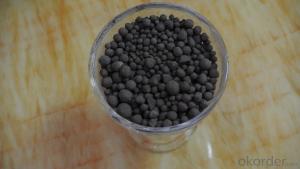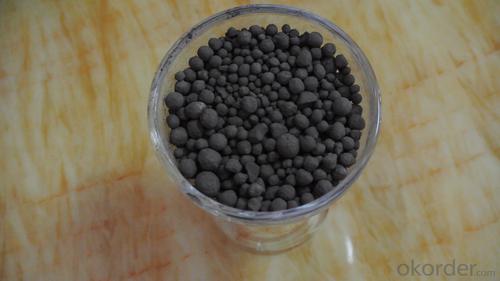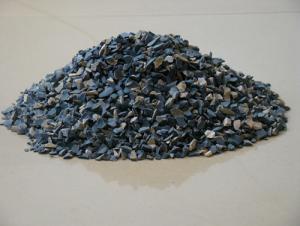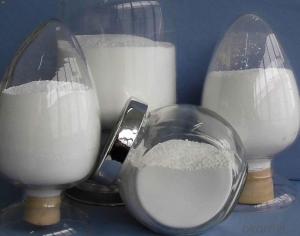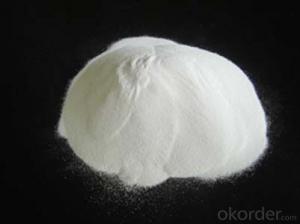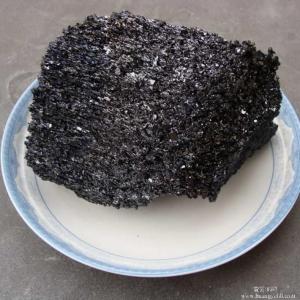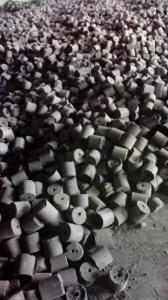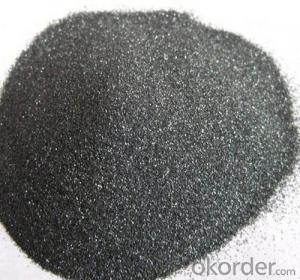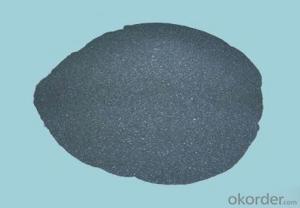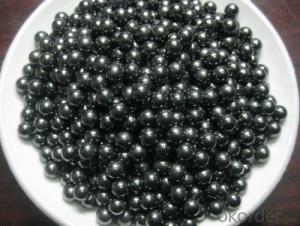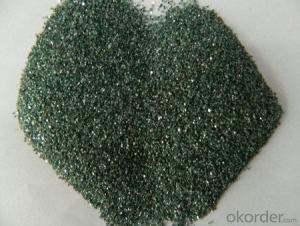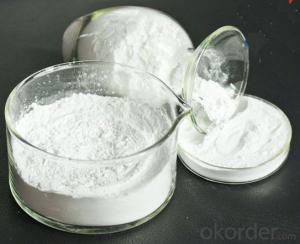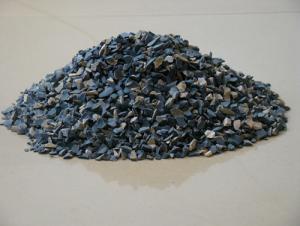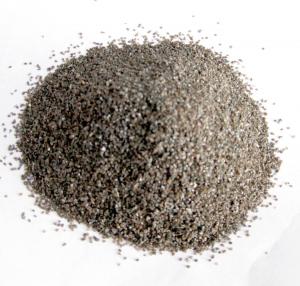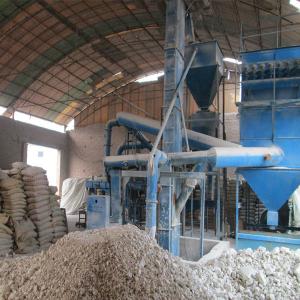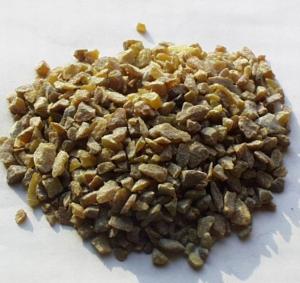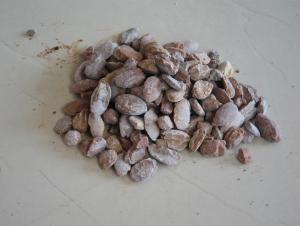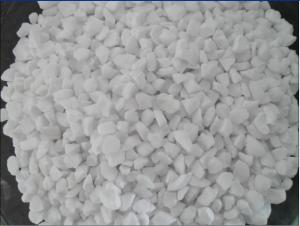Silicon Bonded Silica Carbon Alloy Ball - Raw Materials for Refractory
- Loading Port:
- Tianjin
- Payment Terms:
- TT OR LC
- Min Order Qty:
- 20 m.t.
- Supply Capability:
- 1000 m.t./month
OKorder Service Pledge
OKorder Financial Service
You Might Also Like
Silicon Carbon ball
At present, the iron and steel metallurgy enterprises usually adopt alloying out of the furnace to adjust the steel composition and use the common recarbonizer to adjust its carbon content. When the molten steel is under peroxy state, since the density of recarbonizer is small, it has poor efficiency of adding carbon. On the other side, it can’t sink into the molten steel and there is little possibility of acting with the molten steel, only can act on the top or on surface, so the recovery rate of carbon is low. Nevertheless, many steel enterprises try to resolve the problem by adding carbon cored wire, which increase the production cost and equipment cost, what’s more, it is much difficult t operate.
We has two production lines, the monthly production capacity is 1000 tons.
Specification
C | Si | S | P | H2O | Granules |
20-30% | 45-55% | ≤0.12% | ≤0.2% | ≤0.5% | 20-50mm |
- Q: What are the materials of insulation firebricks?
- The furnaces of firebricks are generally divided into two types, namely, unshaped refractory materials and shaped refractory materials. Unshaped refractory materials, also called castables, is a mix of powdery particles of many aggregates and one or multiple adhesives. They must be stirred well with one or multiple liquids when in use, which has a strong liquidity. Unshaped refractory materials generally refers to firebricks. They have standard rules about their shapes and can also be processed temporarily as needed.
- Q: Are the specification of fireclay bricks and ordinary clay brick the same?
- Do you want to know whether the specifications of fireclay bricks and ordinary clay brick are the same?
- Q: I wanna ask you, which level is b1 fireproof and thermal inuslation matertial ??
- What you said is the pixel! Only that has b1b2. Level b1 is the fireproofing level b1, because the particle does not belong to the fireproofing material. Only can fire?retardant. The wholesale of all kinds of thermal insulation material and construction need to look at the name.
- Q: Is the ball mill used in production of refractories?
- Refractory is a kind of non-metallic material that is of resistance to thermal shock and chemical erosion, low thermal conductivity and low expansion coefficient. The refractoriness of the refractory is not less than 1580℃. The usage of the refractory is broad. Refractory materials include refractory bricks and powders. Abandoned refractory bricks can be recreated as new bricks after they are crushed by a crusher and grinded by a ball mill. The ball mill and crusher are needed to grind and crush the material in the production of the refractory. The ball mill produced by Zhengzhou Xinhai Machinery Manufacturing Co. has excellent performance and there are many successful cases in Inner Mongolia, Heilongjiang and Guangdong. At the request of the national environmental policy, the company adjusts the equipment details, allowing the equipment to ensure the volume of production while reduce energy consumption.
- Q: How to divide the fire rating standards of insulation materials?
- 1. According to the GB8624-97 national standard, building materials can be divided into following levels in terms of combustion performance. A-level: Non-combustible building materials: Materials almost don't burn. B1-level: Fire-retardant building materials: Fire-retardant materials are good at resisting flame. It is difficult for them to burst into fire when coming across open fire in the air or at high temperature. It will not quickly get wilder and when the fire source removes, it will be extinguished immediately. B2-level: Combustible building materials: Combustible building materials can play a certain role in preventing combustion. It will immediately burst into flames when coming across open fire or at high temperature, and will lead to fire spreading, such as wooden pillars, roof frames and beams as well as stairs. B3-level: Inflammable building materials: Inflammable building materials are highly flammable with no flame retardant ability. The fire risk is high. 2.The exterior wall thermal insulation materials can be classified according to fire rating. 1. Insulation materials with A-level combustion performance: rock wool, glass wool, foam glass, ceramic foam, foam cement, close-celled perlite, etc. 2. The insulation materials with B1-level combustion performance: specially-treated extruded polystyrene boards(XPS)/ specially-treated Polyurethane(PU), Phenolics, Polystyrene rubber powdery particles,etc. 3. Insulation materials with B2-level combustion performance: Expanded polystyrene sheets(EPS), Extruded polystyrene board(XPS), Polyurethane(PU), Polyethylene(PE), etc.
- Q: What's the definition of fire endurance of the fire-resistant coating for steel structure?
- 1. Fire endurance. Conduct fire resistance test of any building component according to the standard time-temperature curve, and the time when it is subjected to the fire to the time when it loses support capability or fire insulation function or its integrality is destroyed is referred to fire endurance. 2. Steel has relatively low fire endurance which is usually 0.25h only, namely 15 minutes; 3. Of steel structure buildings, steel can be used as beams, pillars, etc. but its fire endurance is not enough (usually these components have higher requirement on fire endurance, and take pillar as an example, it is usually demanded that the fire endurance should be 2-3h), and under this condition, it needs to brush fire retardant coating so as to raise the fire endurance. As to the specific quantity or types of the fire retardant coating, it is decided upon the actual conditions. In short, the building material needs to meet the required fire endurance of the buildings.
- Q: Who knows how many kinds of fireproof insulation materials are there in the market?
- Portland cement, insulation stone, calcium powder and platycodon grandiflorum are the main raw materials of inorganic active insulation materials. Advanced manufacturing techniques and chemical Technologies have been used to conduct many tests, thus the close-celled inorganic active insulation materials are successfully developed. Products have advantages of fire-resistance, small deformation coefficient, aging-resistance, stable performance, environmentally-friendly, and good compatibility with rendering coating and subtractive wall, security, stability, and also have a life as long as the building itself. Good fireproofness: The materials of fireproof insulation board are inorganic (cement) which has A1-level fire-resistance, are non-combustible materials, and good at resisting fire. I hope my answer can help you.
- Q: What is the type of heat resistance property of high temperature electric furnace ?
- According to the levels of refractoriness : Common refractories: & Gt: 1580 ℃ ~ 1770 ℃ advanced refractories: 1770 ℃ ~ 2000 ℃ AAA refractories; 2000 ℃
- Q: What's the heat conductivity coefficient, specific heat capacity and density of the refractory material of magnesite-chrome brick and magnesia-alumina brick respectively?
- It is suggested that you find some samples of well-known manufacturers, such as Ogilvy and Mather Group, and that will be more correct.
- Q: What are the types of steel refractory materials
- (1) clay refractory brick (2) high alumina refractory brick
Send your message to us
Silicon Bonded Silica Carbon Alloy Ball - Raw Materials for Refractory
- Loading Port:
- Tianjin
- Payment Terms:
- TT OR LC
- Min Order Qty:
- 20 m.t.
- Supply Capability:
- 1000 m.t./month
OKorder Service Pledge
OKorder Financial Service
Similar products
Hot products
Hot Searches
Related keywords
